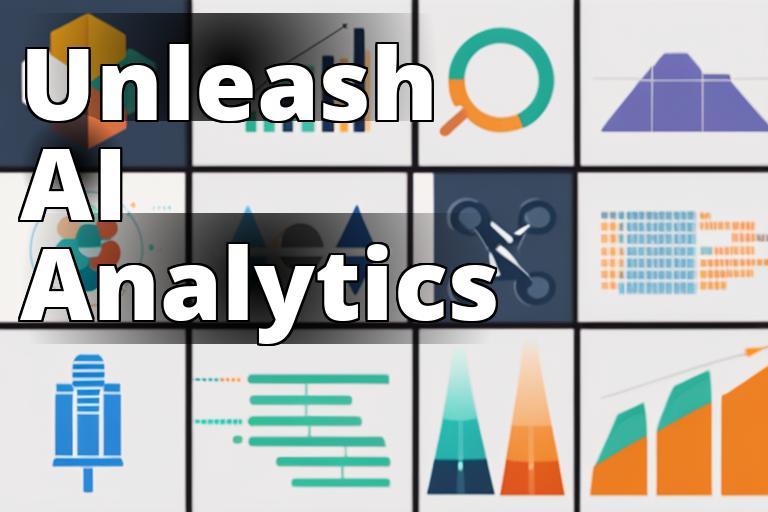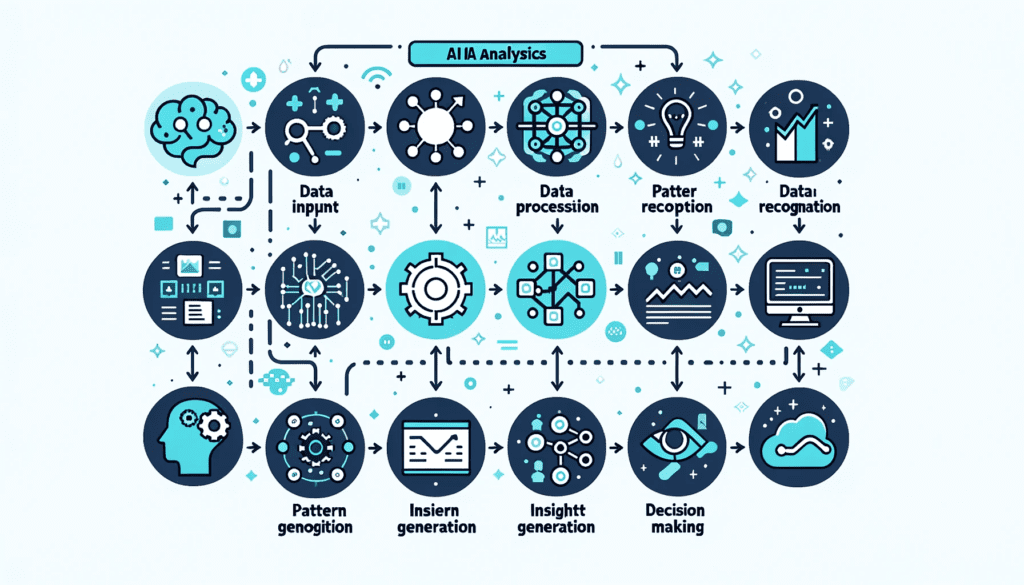Uncover the Power of AI Data Analytics Tools for Productivity Optimization
What you will learn from this article:
- The definition and benefits of AI data analytics.
- An overview of top AI data analytics tools, including Tableau, Microsoft Power BI, Polymer, MonkeyLearn, AnswerRocket, and Coefficient.
- The key features and functionality of AI data analytics tools, implementation considerations, use cases, and tips for selecting the right tool.
In today’s data-driven world, businesses are constantly seeking ways to optimize their productivity and make informed decisions. With the vast amount of data available, it can be challenging to extract meaningful insights efficiently. This is where AI data analytics tools come into play. These powerful tools leverage artificial intelligence (AI) algorithms to analyze and derive insights from large datasets, enabling businesses to make data-driven decisions and improve their overall productivity.
Understanding AI Data Analytics
AI data analytics refers to the use of artificial intelligence technology to analyze and interpret large volumes of data. It involves using algorithms and machine learning techniques to identify patterns, trends, and correlations within datasets. The primary goal of AI data analytics is to extract valuable insights and actionable information that can drive business growth and optimize productivity.
One of the key benefits of AI data analytics is its ability to process data faster and more accurately than traditional methods. AI algorithms can handle large datasets with ease, reducing the time and effort required for manual data analysis. This allows businesses to make quicker decisions based on real-time insights.
AI data analytics also improves decision-making by providing more accurate and reliable information. By analyzing data from multiple sources and identifying patterns, AI tools can help businesses uncover hidden insights that humans may overlook. These insights can lead to better decision-making and improved operational efficiency.
Furthermore, AI data analytics tools can uncover trends and patterns that may not be immediately apparent. By analyzing historical data and identifying correlations, businesses can gain a deeper understanding of customer behavior, market trends, and other factors that impact their operations. This knowledge can help businesses anticipate future trends and make proactive decisions.

Overview of Top AI Data Analytics Tools
There are several AI data analytics tools available in the market today, each with its unique features and capabilities. Let’s take a closer look at some of the top tools that are widely used by businesses across various industries.
A. Tableau
Tableau is a leading data visualization tool that enables businesses to create interactive dashboards and reports. It offers a user-friendly interface and powerful data visualization capabilities, allowing users to explore data and gain insights easily. Tableau’s drag-and-drop functionality makes it accessible to users with varying technical skills.
By visualizing data in the form of charts, graphs, and maps, Tableau helps businesses understand complex datasets more intuitively. It allows users to interact with data in real-time and drill down into specific details. This enables businesses to identify trends, outliers, and patterns quickly, leading to better decision-making.
B. Microsoft Power BI
Microsoft Power BI is a highly useful business intelligence platform that enables users to sort, analyze, and visualize data effectively. It provides a centralized hub for data analysis and reporting, making it easier for businesses to access and share insights across the organization.
One of the key features of Microsoft Power BI is its data visualization capabilities. It offers a wide range of visualizations, including charts, graphs, and maps, allowing users to present data in a visually appealing and understandable way. Power BI also supports interactive dashboards, which can be customized to meet specific business needs.
Another advantage of Microsoft Power BI is its ability to handle large amounts of data. It can connect to various data sources, such as databases, online services, and spreadsheets, allowing businesses to consolidate data from different systems. This comprehensive view of data enables businesses to gain a holistic understanding of their operations and make data-driven decisions.
C. Polymer
Polymer is an AI-powered tool for data analysis that provides users with the ability to visualize and rearrange data without coding skills. It offers a no-coding platform with intuitive features that make data analysis accessible to users with varying technical backgrounds.
With Polymer, users can create interactive charts, graphs, and dashboards to visualize data effectively. Its drag-and-drop functionality allows users to manipulate and rearrange data easily, enabling them to uncover insights and patterns. Polymer’s AI capabilities also facilitate informed decision-making by automating data analysis tasks and extracting valuable insights.
D. MonkeyLearn
MonkeyLearn is another no-coding platform with AI data analysis features that empowers users to visualize and manipulate their data. It offers a range of machine learning capabilities, making it easier for businesses to automate data analysis tasks and extract insights.
With MonkeyLearn, users can create custom models to analyze text, categorize data, and extract relevant information. Its data visualization features enable users to present insights in a visually appealing manner, facilitating better understanding and decision-making. MonkeyLearn’s machine learning capabilities also allow businesses to automate repetitive data analysis tasks, saving time and improving productivity.
E. AnswerRocket
AnswerRocket is a search-powered AI data analytics platform designed for business users. It utilizes natural language question-answering technology to provide real-time insights and analytics. AnswerRocket makes data analysis more accessible and efficient by enabling users to ask questions in plain English and receive instant answers.
With AnswerRocket, users can explore data intuitively and gain insights through interactive visualizations. Its natural language processing capabilities allow users to ask complex questions and receive accurate responses, eliminating the need for manual data analysis. AnswerRocket’s real-time insights enable businesses to make data-driven decisions quickly and efficiently.
F. Coefficient
Coefficient is a free AI tool that connects ChatGPT with Google Sheets for data analysis. It leverages natural language queries to enable users to ask questions and receive relevant answers in real-time. Coefficient’s automation features allow businesses to automate repetitive data analysis tasks and streamline their workflows.
By connecting ChatGPT with Google Sheets, Coefficient enables users to analyze data using conversational queries. This natural language interface makes data analysis more accessible to users without technical expertise. Coefficient’s automation capabilities also save time and improve productivity for data analysts, allowing them to focus on higher-value tasks.

Key Features and Functionality of AI Data Analytics Tools
AI data analytics tools offer a wide range of features and functionalities that enable businesses to analyze and derive insights from their data effectively. Here are some common features found in these tools:
Data Visualization Capabilities
Data visualization is an essential feature of AI data analytics tools. These tools provide interactive charts, graphs, and dashboards that allow users to explore data visually. Data visualization makes it easier to identify patterns, trends, and outliers, enabling businesses to gain insights quickly and make data-driven decisions.
Automated Data Processing
AI data analytics tools automate data processing tasks, such as cleaning, transformation, and analysis. These tools can handle large datasets with ease, reducing the time and effort required for manual data manipulation. Automated data processing ensures data accuracy and consistency, enabling businesses to rely on accurate insights.
Predictive Analytics
Many AI data analytics tools offer predictive analytics capabilities, allowing businesses to forecast future trends and outcomes. By analyzing historical data and identifying patterns, these tools can make predictions and provide insights into future events. Predictive analytics helps businesses anticipate market trends, customer behavior, and other factors that impact their operations.
Real-time Insights
Real-time insights are crucial for timely decision-making. AI data analytics tools provide real-time data analysis and insights, enabling businesses to respond quickly to changes in the market or customer behavior. Real-time insights allow businesses to make proactive decisions and stay ahead of the competition.
| AI Data Analytics Tool | Key Features and Functionality |
|---|---|
| Tableau | – Data visualization capabilities- Interactive dashboards and reports- Real-time insights- Drag-and-drop functionality |
| Microsoft Power BI | – Data visualization capabilities- Centralized hub for data analysis and reporting- Ability to handle large amounts of data- Interactive dashboards |
| Polymer | – No-coding platform- Intuitive data analysis features- Interactive charts, graphs, and dashboards- AI capabilities for automated analysis |
| MonkeyLearn | – No-coding platform- Machine learning capabilities- Custom models for text analysis- Data visualization features |
| AnswerRocket | – Natural language question-answering technology- Real-time insights and analytics- Interactive visualizations- Data analysis through plain English queries |
| Coefficient | – ChatGPT integration- Natural language queries- Automation features- Integration with Google Sheets |
Case Study: How Company X Utilized AI Data Analytics Tools to Drive Productivity
At Company X, we were facing challenges with data analysis and decision-making due to the sheer volume of data we had to process. Our manual methods were time-consuming and prone to errors, hindering our ability to make informed business decisions. That’s when we decided to explore AI data analytics tools to optimize our productivity.
We implemented Microsoft Power BI, a robust business intelligence platform, which allowed us to visualize and analyze large datasets effectively. With its user-friendly interface and seamless integration with our existing Microsoft products, Power BI enabled us to create interactive dashboards and reports effortlessly.
By using Power BI, we were able to automate data processing tasks, such as cleaning and transforming data, saving us countless hours of manual work. The platform’s predictive analytics capabilities also allowed us to forecast future trends, giving us a competitive edge in the market.
Furthermore, Power BI provided us with real-time insights, enabling us to make timely decisions. The ability to drill down into the data and ask natural language questions simplified the analysis process, making it accessible to all employees, regardless of their technical skills.
As a result of implementing Power BI, we witnessed a significant improvement in our productivity. Our decision-making became more data-driven, leading to better outcomes. The time saved from manual data processing allowed our team to focus on more strategic tasks, ultimately driving business growth.
Company X is a testament to the power of AI data analytics tools in optimizing productivity. By adopting the right tool for our needs, we were able to streamline our data analysis processes and harness the insights hidden within our vast datasets. AI data analytics tools have become an invaluable asset for our organization, and we continue to explore new tools and techniques to stay ahead of the curve.
Implementation and Integration Considerations
Implementing AI data analytics tools into existing workflows requires careful planning and consideration. Here are some factors to keep in mind:
- Compatibility and Integration: Before implementing an AI data analytics tool, businesses should ensure compatibility with existing software and systems. Integration options should be explored to streamline data flows and enable seamless data analysis.
- Data Security and Privacy: Data security and privacy should be a top priority when implementing AI data analytics tools. Businesses should choose tools that comply with data protection regulations and have robust security measures in place.
- Employee Training: Training employees on how to use AI data analytics tools is essential for successful implementation. Training programs should be designed to ensure that employees can effectively utilize the tools and derive actionable insights.
While implementing AI data analytics tools may present some challenges, the long-term benefits outweigh the initial hurdles. These tools can significantly improve productivity, decision-making, and business growth when implemented effectively.
Remember, the power of AI data analytics tools lies in their ability to process and analyze vast amounts of data, uncover hidden insights, and provide real-time insights for informed decision-making. By harnessing the potential of these tools, businesses can optimize their productivity and gain a competitive edge in today’s data-driven world.
FAQ
What are AI data analytics tools?
AI data analytics tools are software applications that use artificial intelligence to analyze and interpret data for enhanced productivity.
Who can benefit from AI data analytics tools?
Businesses of all sizes and industries can benefit from AI data analytics tools to improve their productivity and decision-making processes.
How do AI data analytics tools work?
AI data analytics tools use machine learning algorithms to analyze large volumes of data, identify patterns, and generate insights for businesses.
What are the benefits of using AI data analytics tools?
AI data analytics tools can help businesses identify trends, streamline processes, make data-driven decisions, and improve overall productivity.
But aren’t AI data analytics tools complicated to implement?
While implementing AI data analytics tools may require initial setup, many solutions are user-friendly and come with support to ease the process.
How can AI data analytics tools help overcome productivity challenges?
By automating data analysis and providing valuable insights, AI data analytics tools enable businesses to make informed decisions and optimize productivity.







9 Comments
Comments are closed.